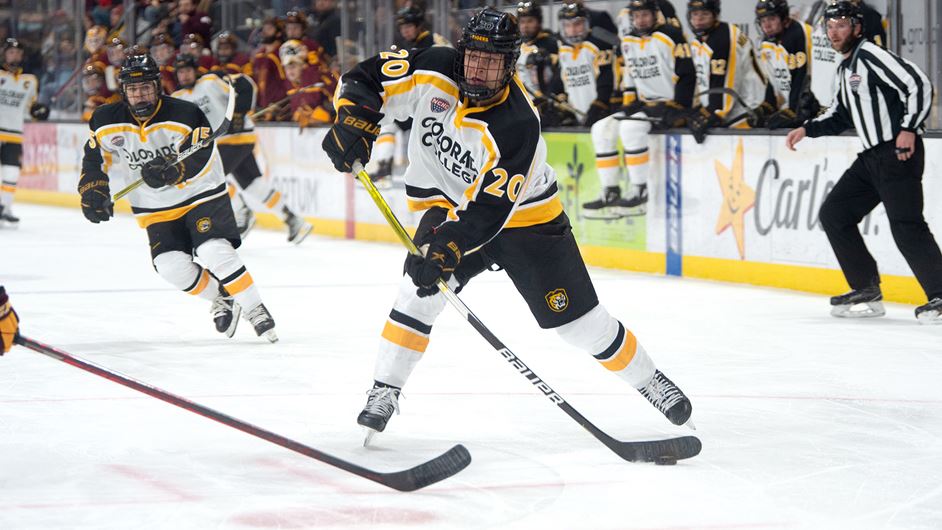
Each week, USCHO.com will pick the top 10 moments from the past week in our Monday 10 feature.
1. Robert Morris reinstates men’s, women’s D-I hockey teams for 2023-24
There was a lot of jubilation at the Robert Morris Island Sports Center on Friday as university president Dr. Chris Howard announced in person the restoration of the men’s and women’s varsity hockey programs for the 2023-24 season.
RMU athletic director Chris King said at the news conference that he had spoken to Atlantic Hockey and College Hockey America commissioner Bob DeGregorio and was told that both programs will have to re-apply for membership in their former leagues. People around college hockey will be surprised if they aren’t readmitted. The CHA needs another team to retain its autobid for the NCAA tournament and Atlantic Hockey coaches USCHO.com has spoken to are emphatically in favor of RMU’s return.
Men’s head coach Derek Schooley – who is also RMU’s director of men’s and women’s hockey operations – will continue at the helm, while the school says it will look nationally for a women’s head coach.
2. Arizona State, Colorado College split the weekend
The Sun Devils took the first game of the series at Colorado College’s Ed Robson Arena on Friday, 5-2, padding a late 3-2 lead with a pair of empty-net goals. The Tigers returned the favor on Saturday, getting an empty-net goal to make it a 4-2 win.
Arizona State is at 10-10 after the weekend, facing a steep, yet still attainable path to the NCAA tournament. The Sun Devils probably need a 12-2 record the rest of the way out to ensure a berth to the post season, with No. 9 Cornell at home for two, and then series at Boston University, RIT, and No. 1 Minnesota State looming.
CC has sold out 10 straight games at their new arena. Former Alaska governor Sarah Palin joined Ed Robson at Friday’s game.
Peter Mannino was acting head coach for the weekend while Kris Mayotte serves on Team USA’s coaching staff at the IIHF World Junior Championship.
3. Ohio State picks up pair of non-conference wins
No. 17 Ohio State took both ends of a home-and-home series against Bowling Green, winning in overtime in Columbus on Thursday, 4-3, and picking up a 3-2 win at a sold-out Slater Family Ice Arena on Friday. Jakub Dobeš got the win in net for the Buckeyes both nights, including a 42-save performance at Bowling Green.
About the capacity crowd of 5,000 on Friday, BGSU coach Ty Eigner said, “I hope the people that came really enjoyed the experience, because there are bigger buildings, and there are newer buildings, but Slater Ice Arena is as good a college rink as there is in the country. It is an electric arena, and the crowd was awesome.”
4. Zero attendance will be situation at Northeastern
While Bowling Green packed their barn on Friday, Northeastern announced earlier that same day that it would not allow fans in the building for home games in any of its sports as of Dec. 19. In addition, Sunday’s men’s basketball game against Vermont was postponed because of positive COVID-19 tests among the Huskies.
Northeastern’s next home series for men’s hockey is against LIU on Jan. 7 and 8 with a matinee game for the women’s team at 2:00 on Jan. 7 vs. Merrimack.
5. Will other schools ban fans, too?
So far the Huskies are the first to announce the prohibition of spectators, but eyes are on other programs as well as the Omicron variant appears to be spreading rapidly among college students and professional athletes.
Cornell shut down its entire campus in Ithaca, N.Y., after COVID-19 was found to be spreading quickly among the student body, despite a 97% student vaccination rate. Cornell’s COVID-19 web page said at this writing that there were 1,502 cases last week.
The next home game on the docket for the Big Red men’s team is not until Jan. 21 as they are scheduled travel to Arizona State, North Dakota, Yale, and Brown before returning to Lynah Rink to host Princeton and Quinnipiac. The Cornell women are slated to host Dartmouth and Harvard on Jan. 7 and 8.
6. How big of an impact will COVID have when play resumes?
Not to get too pessimistic, but with games suspended in college and pro sports and players placed on inactive rosters for COVID in the NHL, NBA, and NFL, it does seem unlikely that NCAA hockey will escape a similar situation. Last season, college hockey responded quickly and with agility to adjust schedules and protocols. Every conference has procedures in place should this become necessary.
Things moved very quickly in March 2020 and the next two weeks could be a bit frantic if the situation that Cornell University has seen repeats elsewhere. COVID-19 has caused a few games this season to be rescheduled. But whispers around college hockey suggest the virus has sidelined more players than has been made public.
7. A very NCAA-flavored Team USA heads to World Juniors
Providence coach Nate Leaman and his staff – which includes NCAA bench bosses Ted Donato of Harvard and CC’s Mayotte – have made the journey with Team USA to Red Deer, Alberta. After a 48-hour isolation in their hotel, they got back on the ice on Saturday in preparation for games beginning Dec. 26.
While Team USA may not have the firepower up front that they had on last year’s gold-medal team, they may have the best corps of defensemen in the tournament. Boston University goaltender Drew Commesso is considered the favorite to get most of the time in net for the Americans. All but two of the 25 players on the roster are current or committed NCAA players and six of those are repeats from the 2021 team.
USCHO.com previewed the USA WJC squad on last Wednesday’s USCHO Spotlight podcast with NHL draft and prospects analyst Chris Peters.
8. Not much wiggle room at top of standings
Three points for a win means that standings can change quickly. With an 11-point lead at the top, only the CCHA has some breathing room between first-place Minnesota State and second-place Bemidji State at the break. Yet the Beavers have two games in hand vs. the Mavericks, so even that conference has essentially one weekend of separation.
North Dakota’s six-point lead over second-place Western Michigan could evaporate in one weekend series, while across the rest of college hockey, fewer than two games – and as little as one point – separate first from second.
Coaches will point to parity brought on by a bucket load of talented players, great coaching and video analysis, and the evolution of the game as reasons why things are so close. Whatever the reasons, it should mean great races down the stretch.
9. Non-conference records at break a preview of at-large bids
A conference’s overall non-league record is an excellent predictor of how many at-large bids they’ll draw, as it is reflected in the strength-of-schedule numbers in the RPI. At the semester break, the Big Ten at a .696 winning percentage and the NCHC at .655 are well positioned to get additional teams in. (Could we see five from the NCHC and three from B1G?) The CCHA and ECAC are sub-.500 and should be concerned. Atlantic Hockey is likely to have just the automatic qualifier.
10. Bob Peters remembered
A sports writer recently lamented on Twitter that the word “legendary” has become overused as journeyman major leaguers will even receive that appellation from overly exuberant scribes and in social media headlines.
But there’s no exaggeration when the word legendary is applied to R. H. “Bob” Peters, who passed away last week at the age of 84. Most noted as the long-time head coach at Bemidji State – where he had national championships at the D-II, D-III, and NAIA levels – he was also instrumental in the evolution of D-I hockey as the commissioner of College Hockey America. Beloved and respected widely, Peters was named a Hobey Baker Legend of Hockey in 2001.
ᐧ


